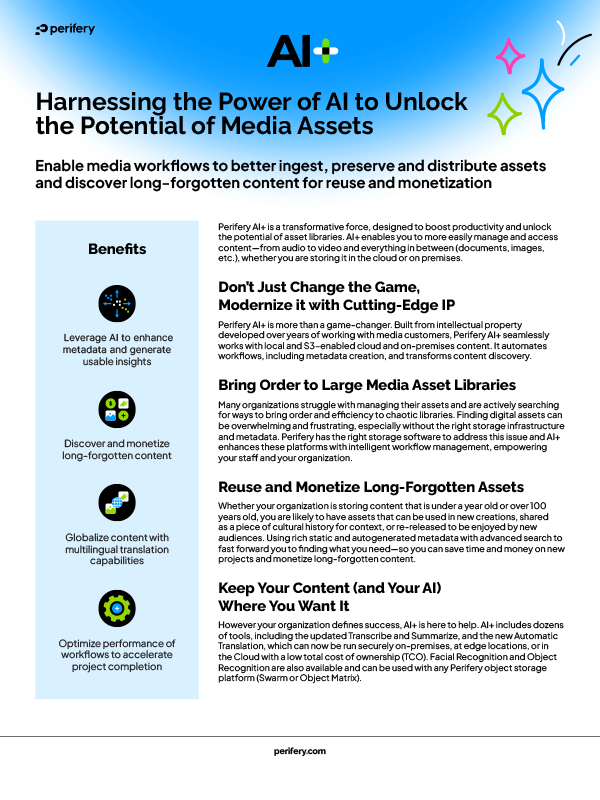
Media organizations are storing and managing more digital assets than ever. Yet, despite sharing similar goals – seamless collaboration, enhanced performance, and the secure and efficient management of vast content libraries – they each face unique challenges in achieving their objectives. From accessibility issues to safeguarding concerns, more media teams are considering a multi-cloud approach to overcome the hurdles in their workflows.
But what exactly is a multi-cloud approach? And can it really help media organizations thrive in a rapidly evolving digital landscape?
1. What is multi-cloud?
A multi-cloud approach combines multiple cloud solutions, including private and public clouds, to offer access to more connected services. This approach enhances data protection, provides higher levels of security, and removes the reliance on any single external provider.
By leveraging a multi-cloud environment, your media team can optimize their content storage needs, prevent data bottlenecks, and scale resources as required. It also allows you to avoid vendor lock-in and take advantage of specialized services from different providers. This can elevate your team’s capabilities and enable workflow adaptability in an industry that requires an agile approach.
2. What type of cloud deployment provides the best solution for a media company?
Different types of cloud offer unique benefits. The ideal combination of cloud solutions depends on the specific needs and requirements of your organization.
- Public clouds offer scalability and convenience but tend to fall short in cost and control options.
- Private cloud provides transparent pricing control, security, and customization
- Hybrid cloud combines the benefits of both public and private clouds, offering flexibility, scalability, and the ability to choose the most suitable environment for different workloads.
Media teams need to evaluate their specific needs and consider factors such as cost, security, compliance, scalability, and complexity, when selecting the most suitable cloud approach for their business.
3. How will a multi-cloud approach affect our existing workflows?
When implemented correctly, the transition to multi-cloud storage should be a seamless process. However, it requires careful planning and coordination to ensure workflow continuity. Organizations need to assess the compatibility of their existing systems with their selected cloud solutions and develop a comprehensive migration strategy.
Interoperability considerations are also vital to determine whether assets can be shared across different cloud solutions. Thorough planning, coordination, and assessment will allow organizations to maintain productivity while embracing the flexibility and scalability offered by multiple cloud solutions.
4. Are there any risks to adopting a multi-cloud approach?
As with any new approach, there are certain risks that organizations should consider. Adopting new technology requires a solid understanding to ensure smooth implementation. Managing data across multiple cloud solutions can be difficult, especially in the early stages. Media teams need to prioritize the protection of their assets by implementing robust security measures from the get-go. Working with experienced solution providers to audit existing workflows, identify potential risks, and create safeguarding and disaster recovery plans, can help mitigate issues before they arise.
5. Can a multi-cloud approach completely remove security concerns?
Although a multi-cloud approach provides enhanced security measures, it cannot completely remove the threat of unauthorized access. Nothing can. However, by leveraging redundancy, organizations can minimize the impact of potential downtime or data loss. Distributing media assets across multiple cloud solutions can facilitate the continuity of operations in the case of an outage or security breach. Additionally, implementing Digital Content Governance (DCG) platforms can further protect data, ensure business continuity, and future-proof content and associated metadata.
6. How can a multi-cloud approach help long term business goals?
A multi-cloud approach offers greater flexibility by combining best-of-breed cloud platforms. It can reduce long-term costs through optimized infrastructure and resource allocation and facilitate workflow and workforce optimization through better load balancing.
By harnessing these benefits, media teams can align cloud strategies with long-term business goals, helping them to stay agile and adaptable in a rapidly evolving landscape while also unlocking new opportunities for growth to gain a competitive edge.
A multi-cloud approach offers many advantages for businesses seeking seamless accessibility, enhanced collaboration, and secure management of their valuable media assets. By combining multiple cloud solutions, organizations can enjoy greater flexibility, avoiding vendor lock-in and tailoring platforms to their specific needs. However, a multi-cloud strategy requires proper planning and understanding. Perifery works with organizations to deploy intelligent nearline and archive storage solutions, helping media teams achieve operational efficiency and complete confidence in the safety of their content. Get in touch to learn how to leverage the most efficient storage solutions to drive efficiency, flexibility, and resilience for the long term.
